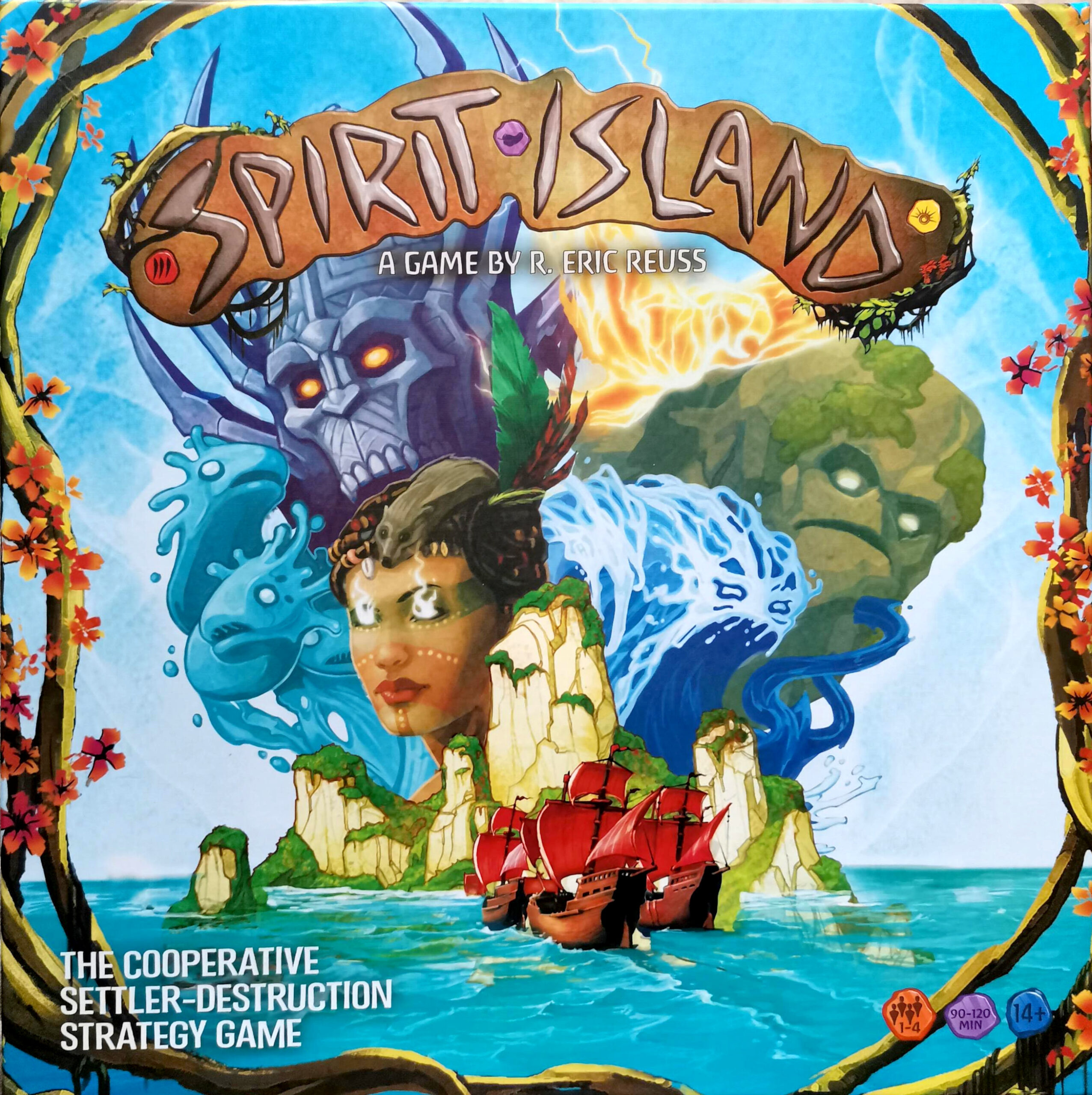A lot of Eurogames involve building up a town, a city, a land, or an empire. But what happens when the formula gets flipped on its head? What happens when we actively try to prevent the growth and expansion? Let’s find out with R. Eric Reuss’ 2017 game, Spirit Island.
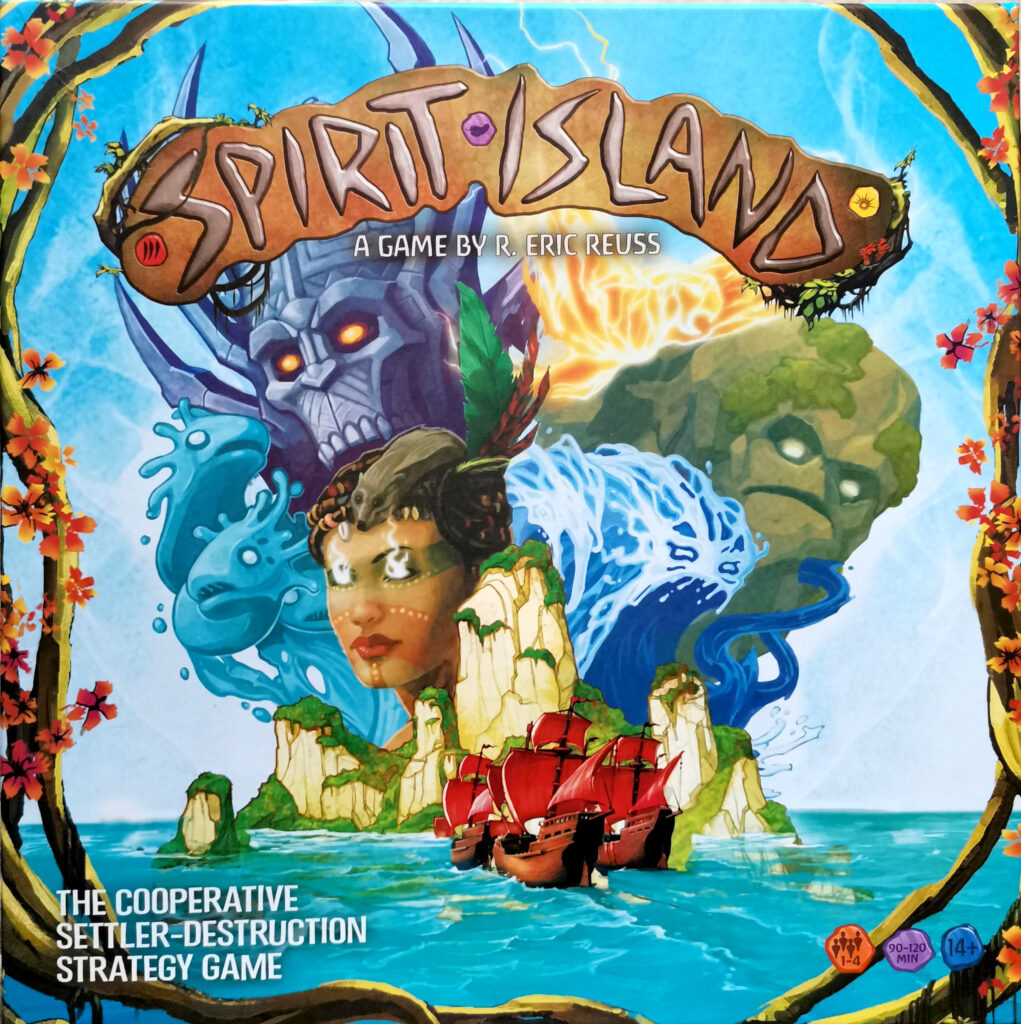
What’s In The Box?
As is customary here, let’s start with taking a look inside the box. Spirit Island is packed with pieces; wooden pieces, plastic minis, cards, cardboard player boards, map boards, dividers, and some natty little lift-out plastic organisers.
The titular island is made up of a number of land boards – one per player. The land boards are an unusual undulating shape, and have a really clever design. While a solo player can play the game with one board, two players can perfectly mesh two boards together. As can three, or four! The clever design means that the boards always mesh perfectly. They’re also double-sided, one side more functional for starters, and the other, more realistic-looking side for advanced players.
The cards have really nice artwork, and the graphic design and iconography is great. Everything is really clear and easily discernible at a glance. There’s a small deck of half-sized cards which is what is what’s used to drive the invaders’ turns. The cards are all really good stock and feel like they’d happily endure a lot of play without needing to be sleeved.
New Meets Old
One of my favourite things with the overall design of Spirit Island is the mixture of plastic and wood for the playing pieces. Initially even the idea of this mixture was a real turn-off for me. I don’t really like plastic pieces at the best of times, but mixing them with wooden ones? It seemed like heresy, like mixing together Skittles and M&Ms and taking a big mouthful.

However, after playing for a while, I realised it’s actually very clever. The ‘new’ of the invaders is all plastic, angular and spiky, while the defending spirits and Dahan (the original islanders) use smooth, rounded wood. This contrast between old and new, or good and bad if you like, creates a really nice juxtaposition.
Throughout the box, everything feels like it’s really well-made and using strong materials, it’s a big thumbs-up from me.
How Does It Play?
The Concept
Spirit Island puts the players in the role of one or more spirits – ancient presences who have ruled the island for as long as anyone can remember. The New World is on its way though, with invading forces coming from Europe, looking to claim the island as their own building, driving out the indigenous population, and ravaging the land for its resources. The spirits have other ideas, and through a combination of controlling the island’s environments, wreaking their own havoc, and instilling fear into the invaders, hope to drive them away for good.
Play is card-driven, and as your spirit’s presence on the island grows, so does its power, and spending earned energy to play cards is how you’ll push and pull the invaders, subject them to fear, and try to destroy their towns and cities. To win you either exhaust the Fear deck, or destroy enough towns and/or cities according to the growing terror level, which increases as fear increases. If the invaders destroy all of your presence however, spread too much blight through the island, or complete their colonisation by exhausting the invader deck, they win.
Gameplay Basics
Each player chooses a spirit board which dictates how they’ll play the game. Some are better at defending, while some are great at building fear. The back of each spirit board explains who they are and how they should be played. It also tells you how difficult they are to use, which is good to know when you’re starting out, because this game is anything but easy. Each of the spirits also comes with its own starting deck of four cards, unique to itself.
The island board(s) are drawn at random, and although each are the same shape, the positions of the lands (wetland, mountains, jungle and sands) are different on each, as are the locations for the starting Dahan locals, blight, towns and cities.
Each of the player boards has circles which represent two tracks: one for the energy earned each turn, one for the number of cards that can be played in each turn. These circles begin the game nearly completely covered with presence markers, which are little wooden discs. At the start of a turn you can choose one of several actions, most of which allow you to place at least one of these discs on the island, representing your presence there. As you move these discs from your board to the map, you earn more energy or can play more cards, in a similar way to the way player boards work in games like Great Western Trail or Maracaibo.
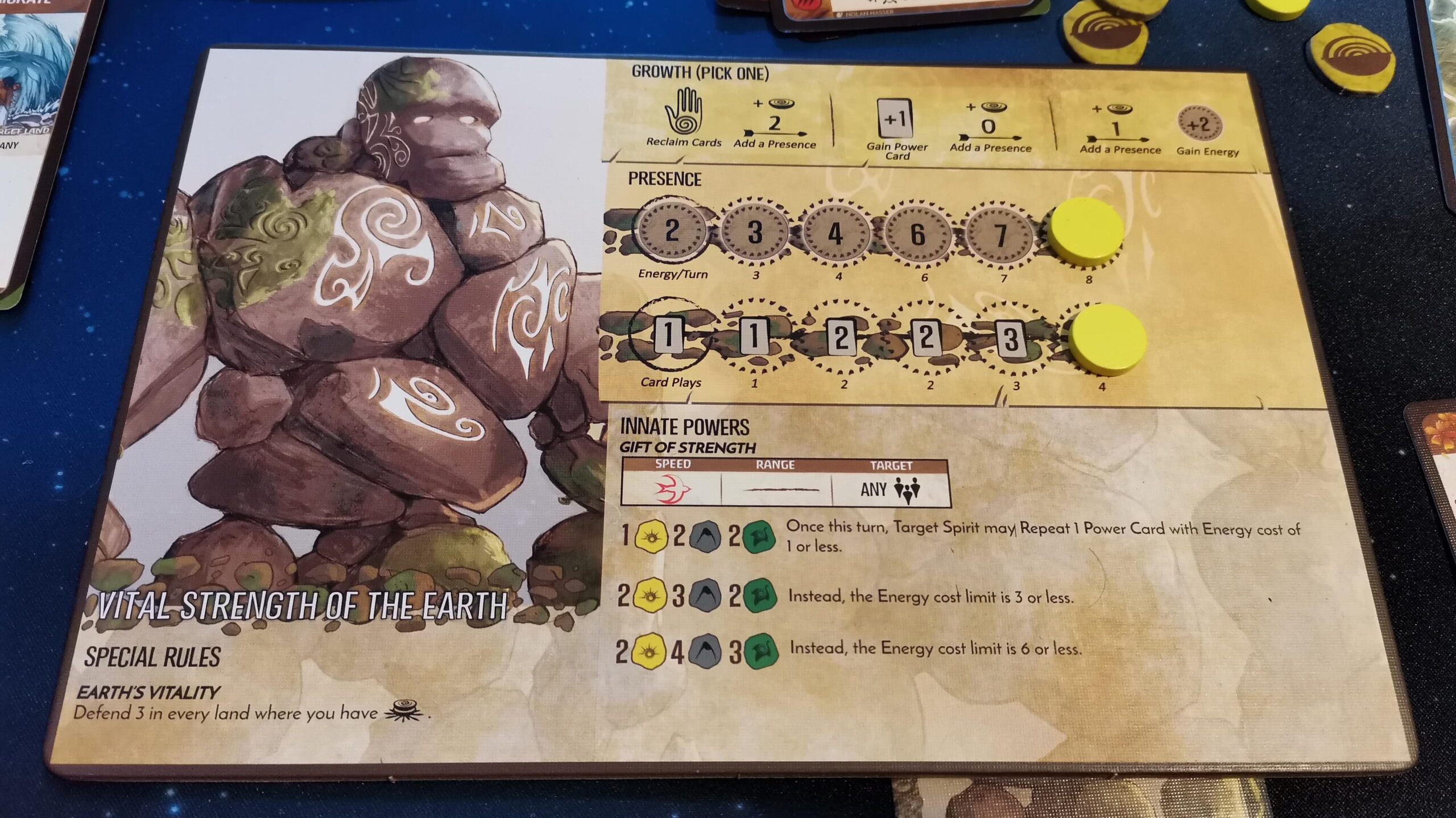
Turn Structure
Each turn starts with the players choosing which set of actions they’re going to do for the Growth phase. Most involve placing at least one presence disc, then either taking some extra energy tokens, a new power card, or drawing back your discard pile into your hand. Then you claim the energy for that turn, and choose which power cards you’re going to play with your accrued energy. Power cards are either resolved immediately (fast), or at the end of the round (slow). Then we play any Fear cards queued up for the coming turn, and resolve their effects.
Next it’s the invaders’ turn. The invaders have their own board to track their fear, the level of terror, and the advancement track for their exploration. If there’s a card in the ravage space, any invaders in lands of that type are attacked, but If the spirits have managed to raise any defence at the start of the round they can negate that much damage. Combat is a little complicated to explain here, but if any Dahan in the land survive the attack, they fight back, and fear is gathered for any towns or cities that are destroyed. If two or more damage is done to the land, a (nasty, modern, plastic) blight token is added to the land.
Next, the invaders build, using the land card that’s in the Build slot of their track. Towns and cities are added to the map, again, by following certain rules we won’t go into here. Suffice to say, the more towns and cities on the island, the worse things are going to get for us. so we try to use powers to make sure there aren’t invaders on the lands to be built on.
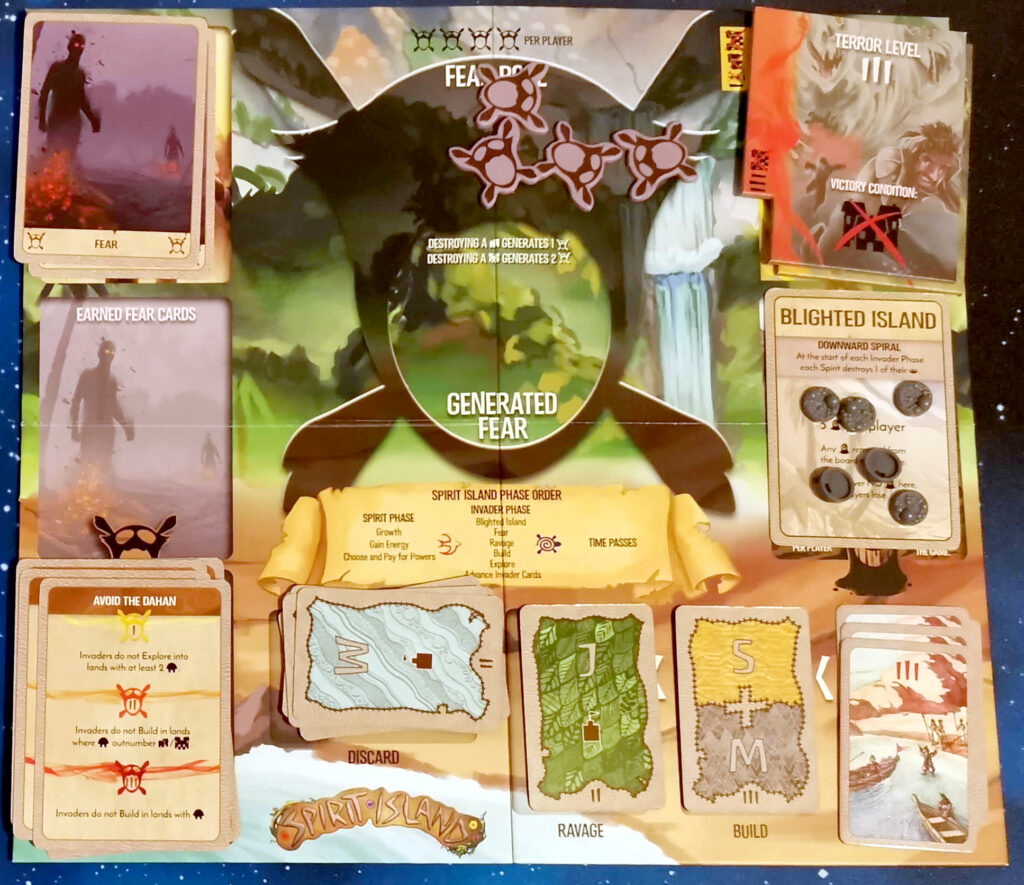
Finally, the invaders explore. A new card gets turned from the top of the invader deck, and provided the land type on that card has a building on it, or is adjacent to one that does, or is next to the ocean, explorers are added to the map. Then the clever bit happens. All of the invader cards slide one space to the left. The ravage card for this turn is discarded, the build card will be the next turn’s ravage, and this turns explored lands will be the ones built on next turn. This knowledge of what’s going to happen in the following turn is the key to winning, by forward planning and choosing your powers carefully.
Finally, the slow powers played at the start of the turn are resolved. And now we’re ready for the next turn.
Power Plants
Because plants = nature, right? And nature’s good.
In Spirit Island, the power cards played each turn have multiple functions. Firstly, they perform the actions stated on the card. These are usually:
- Push – if the target land is within the specified range of your presence discs on the board, you can push invaders and/or Dahan of the specified type into neighbouring lands.
- Gather – with the same range and type stipulations from the Push action, invaders and/or Dahan can be pulled into the target land from any adjacent lands.
- Defend – this adds a number of defence points to offset the ravage damage for the forthcoming invader action.
- Damage – the amount of damage specified can be applied to one or more invaders in the chosen land.
- Fear – finally, you can add the number of fear tokens from the fear pool to the earned fear. If all the tokens are removed from the pool, a fear card is moved from its deck to the space to be resolved in the coming turn. If this action uncovers a new Terror Level card, that’s moved to its space on the invader board and reduces the requirements necessary to win the game.
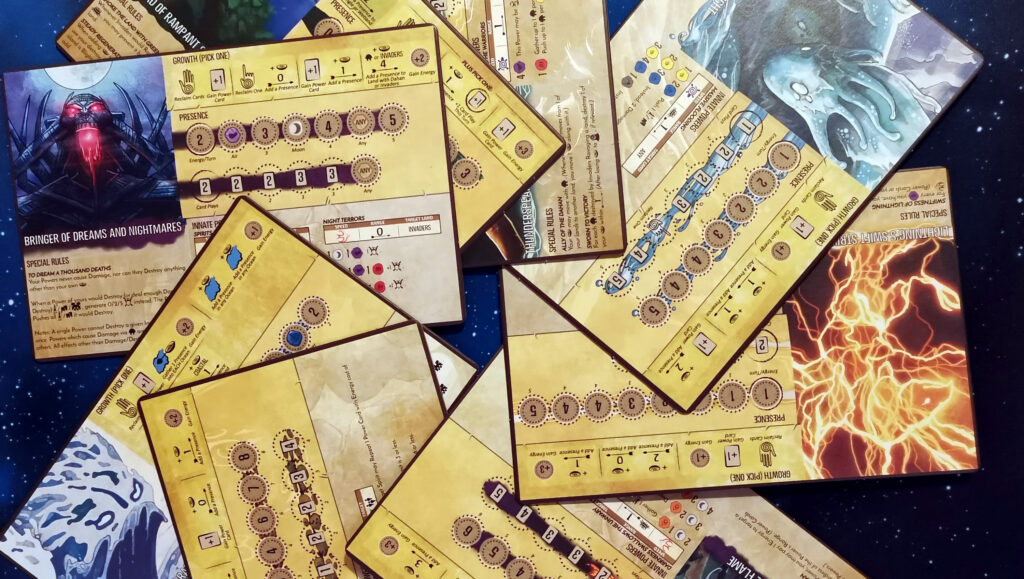
Secondly, each card has a number of elemental symbols on it. If the total number of these elements played on your turn matches those printed on your spirit’s board, you can use additional special powers. These are easy to overlook, but can be stacked with your power cards to make some really powerful combinations.
Putting It All Together
I’ve summarised the main cycle of the game above, but in all honesty there’s a lot more to it than than it might sound like. Strategy is a huge part of Spirit Island, and learning how to play your cards, and which to play when, is a real art. The fact that you know exactly what the invaders are going to do on their turn sounds like it should make it simple, but it doesn’t . Things start off slowly, and mid-game can feel like you’re being swamped if you haven’t managed to get the upper hand. But the end of the game when the invaders are swarming in, that’s where things build to a crescendo and the game escalates to something special.
There’s something immensely satisfying when you’re able to play your cards perfectly, shifting invaders wherever you want them, smiting them from your island, and flipping fear card after fear card. But even when it feels like the world is crumbling all around you, there’s usually a way to claw your way out of the mire and snatch victory from the jaws of defeat.
Upping The Ante
Let’s not beat around the bush here – Spirit Island is a tough game. It’s a difficult puzzle to solve, because of the combination of random island layouts, shuffled invader deck, shuffled power cards, and eight spirits to choose from in the base game. But if you do feel you’ve got the measure of the game, there are a lot of ways to spice the game up. Firstly, there are adversaries you can introduce. Each of three adversary boards represent either Brandenburg-Prussia, Sweden or England, and each has up to six levels of difficulty, which can be added cumulatively. These can add extra buildings, blight, make the invaders more difficult to defeat – just generally make your life much more difficult.
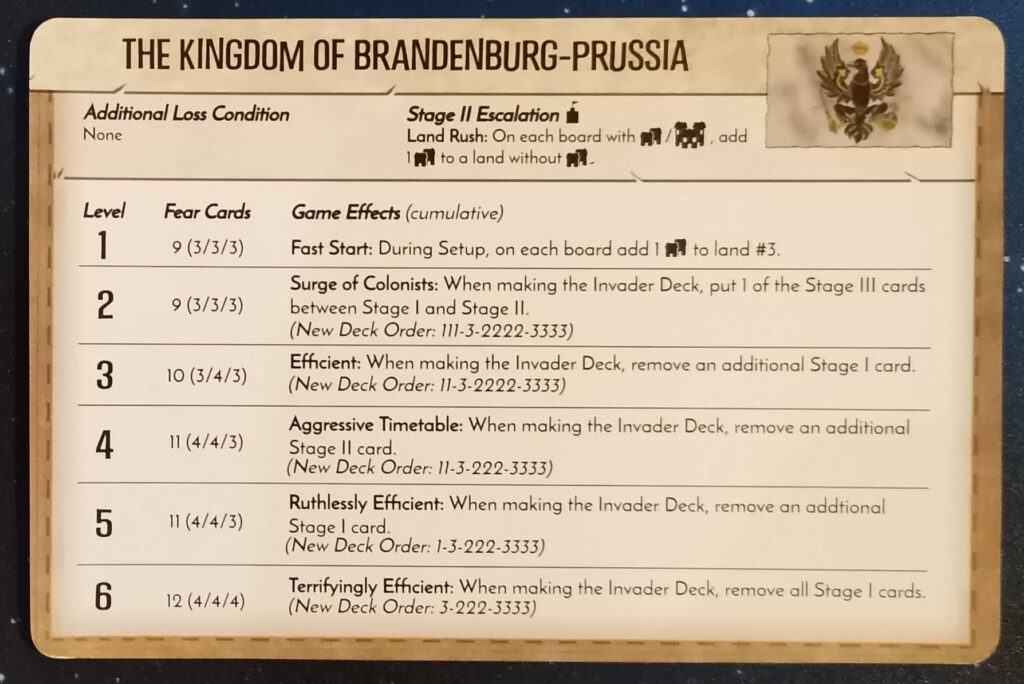
There are also scenarios that can be introduced, which also make things more difficult and change rules, setup and victory conditions. On top of all of that, the island boards can be flipped to the more realistic side, which changes the way the game plays slightly, and again, makes things more challenging.
What’s really, really good about all of this though is that these changes can be added in any combination you like. It might sound like a messy way to do things, lacking structure in what you’re doing and unable to compare scores with others, but thanks to a table in the back of the rule book, you can cross-reference your difficulty choices to get a value, which then becomes a modifier for calculating your final score.
Final Thoughts
I know the review is longer than I’d usually write, so I apologise if it’s felt like a wall of text so far. I wouldn’t normally go into so much depth, but I felt it was important for this game, because there’s a lot going on, and I felt I went into the game pretty blind, even after reading recommendations and seeing a couple of playthroughs. The game loop is actually pretty simple when it comes down to it, but the choices you make with literally every action of every turn, really matter.
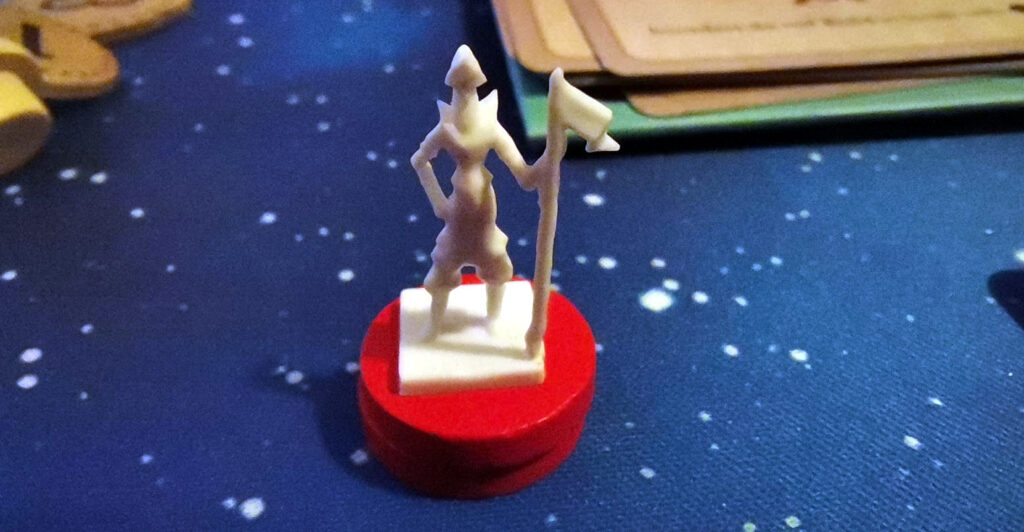
I bought this game because it’s very highly recommended for solo mode, and because we’re currently living in a world of lockdowns and social distancing, the solo modes of games are important to me. As a single player, single spirit, single board game, it’s an excellent game which plays out in around an hour. But it’s perfectly reasonable to pick two spirits and a two-board island and play that solo too. Any more than that, and its possible, but it will frazzle your brain exponentially with every spirit you add.
As I mentioned earlier, it feels like it should be an easy game. At the start of the turn you can see where everything is on the island. You know what cards you’ve got, how much energy you’ll have. You know which lands will be ravaged and which will be built on. The only thing you don’t know is where explorers will be introduced after all of that happens. But it really isn’t. Every card feels like a knife-edge decision, like the entire balance of the game could swing on one wrong decision. As the game progresses, the tension rises as your powers increase, and as more and more invaders pile their way onto your island, it really feels like the final scenes of a good film or book playing out.
I’m really happy with the way difficulty is handled. Being able to choose between different adversaries and scenarios, and then choosing the level of added difficulty within, it feels subtle and personal. It took me a few plays to beat Brandenburg-Prussia on level 1, but when I did it felt great, and immediately made me want to try again, but throwing a few more things into the mix.
Theme And Schemes
Theme can be dry in a Eurogame, but in Spirit Island it’s alive and well. As I mentioned earlier in the review, the contrast between the wood and plastic is subtle, but really nice. Physically moving little buildings and people on and off the map reinforces the feeling of what’s happening through the cards.
The designer added some notes in the back of the rule book explaining the idea of the anti-imperialist theme and anti-euro style, and it’s a really nice touch. It shows where the ideas were born, and how it came to fruition. There’s even a section about each empire, and the alternate versions of history that bring us up to 1700 AD, and the setting for the game. The history of the islands, the story of the Dahan – everything is there in delicious flavour text and lore.
I’m properly in love with Spirit Island. It’s so tight, everything works together perfectly. The way that everything is modular, from the board down to the difficulty. It’s pretty much the perfect Eurogame, if you like difficult puzzles and area control that is. It might not tick all the boxes for everyone. With higher player counts the game can drag on a little, as everyone has to talk and plan, to coordinate their efforts to get the best result possible. But it’s a great co-operative experience which gets the whole table talking. I’m really failing to see any negatives with it. There’s an expansion which adds new mechanics, spirits, and powers, which I’ll definitely be picking up in the future.
Spirit Island is a fantastic game for solo players and small groups alike. Get it.
